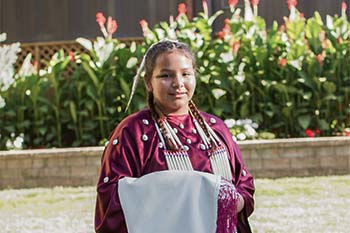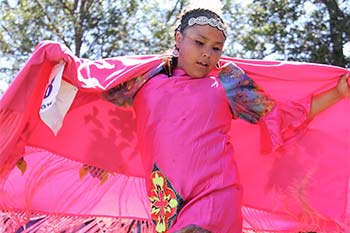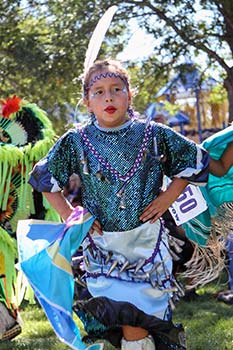Home » Native American Culture » Powwow » Powwow Dance Styles for Women
Lakota (Sioux) Powwow Dance Styles for Women and Girls
Long ago, the Lakota (Sioux) people would dance to celebrate the coming of spring and their relationship with the Earth. Dance was a form of prayer thanking Wakȟáŋ Tȟáŋka — Great Spirit — for another year of life.
Every powwow is different, but most gatherings are considered either a traditional wačhípi — dance — or the more contemporary powwow contest.
Traditional powwows are held to honor groups or individuals. These gatherings are more ceremonial in nature and participating dancers are gifted a minimal amount of money for their attendance. Contest powwows, however, are typically larger competitive events that provide prize money for dancers.
St. Joseph’s powwow, “Gathering of the Wakȟáŋheža” is a contest-oriented event. Our goal is to celebrate each other, especially the wakȟáŋheža — little beings!
Women began participating in the dance circle around 1953. Before that time, they were not permitted in the dance arena and stood in the background — usually behind the drums — and sang. Today, women have three styles of dance and regalia.
Let’s walk through powwow dances performed by females.

Traditional Dance
Native American women are regarded as the life-giving force that nurtures the next generation of youth.
Traditional dancers wear long, beautiful buckskin dresses or trade cloth adorned with meaningful designs made from beads, animal teeth, quillwork, shells and ribbon.
Most dancers carry a shawl draped over their arm and a feathered fan in their hand as they move in a stationary manner on the outside of the circle.
During the honor beats — the stronger, louder and slower beats heard in the song — they lift their feather fan to show their pride and appreciation for the Creator’s blessings.

Fancy Shawl Dance
The first impression people often have of the women’s fancy dancers is that of butterflies.
Dancers wear decorated shawls that complement a satin dress and knee-high beaded moccasins or decorated leggings. The decorated shawl is made of cloth and fringe, reminiscent of the decorated buffalo robes worn in the past.
The faster pace of the drum challenges dancers to keep in time with the beat while coordinating their fancy footwork and graceful movements.
Like the men’s Fancy Dance, this contemporary dance style was introduced as powwows became more competitive.

Jingle Dress Dance
The Jingle Dress Dance came by way of a holy man’s vision.
The holy man was providing care for a sick girl when a dream came to him. In his dream, four girls wearing dresses adorned with tiny cones — which made a very distinct sound — danced for the healing of the little girl.
Upon his awakening, he instructed his wife to make dresses and found girls to dance. The sick girl was healed!
The Jingle Dress Dance has been around for approximately 100 years. Tribes of the Plains borrowed the dance from the Chippewa tribes of the Great Lakes region.
This dance style is very popular among young female dancers. You can hear them coming from a distance as their many metal cones make a unique jingle sound!
We hope you can join us for our Annual Powwow Celebration and see these dances in person! For more information on our powwow, please visit stjo.org/powwow.
“I feel like I become one with the dance and no one can stop me.”
